


 FIRE INVESTIGATION REPORT
FIRE INVESTIGATION REPORT
50 Rawhiti Road, Manly, Auckland
Act
Information
Official
the
Under
Incident Information:
F3756563
Released Suspicious Fire
2:38 p.m. 6 June 2023
Report completed by:
Michael Hoyne, Specialist Fire Investigator
Fire and Emergency New Zealand, Te Hiku
Fire Investigation Report
Page 2 of 44
Table of contents
Table of contents .................................................................................................................................................. 2 Author’s brief ........................................................................................................................................................ 3 Executive summary .............................................................................................................................................. 4 Terms of reference ................................................................................................................................................ 5 Description and use of building .......................................................................................................................... 6 Pre-incident events ............................................................................................................................................. 10
Act
Discovery of fire .................................................................................................................................................. 11 Fire and Emergency New Zealand response .................................................................................................... 12 Process of investigation ..................................................................................................................................... 14
Interviews
14
Scene Examination
14
Area and point of origin ...................................................................................................................................... 41
Area of Origin
41
Point of Origin
41
Information
Conclusions ........................................................................................................................................................ 42
Supposed Cause
42
Elimination of Other Possible Causes
42
Report approvals................................................................................................................................................. 43 Appendix 1: Witness Details [SENSITIVE DO NOT DELETE] .......................................................................... 44
Official
the
Under
Released
Fire Investigation Report
Page 3 of 44
Author’s brief
My full name is Micheal Lee Hoyne. I am a Specialist Fire Investigator for Fire and Emergency New Zealand (Fire
and Emergency).
I have served with Fire and Emergency, since December 2020. I have been responsible for determining the origin
and cause of fires since 2022.
Act
I have completed the following training courses:
Fire Investigation 1 May 2022
Fire Investigation 2 November 2022
I have attained the following tertiary level qualification
Certificate IV in Electrical- Fire Protection Control Systems
I have attained the following qualifications by examination:
Fire Weather index-2022
Information
Intermediate Fire Behaviour 2022
CIMS Incident Management Level 4 2022
I have the following memberships:
Official
Membership of Fire Investigators Association of New Zealand
Membership of the Institution of Fire Engineers
Membership of the international Association of Arson Investigators
the
I have the following additional experience:
FENZ TAPS Trained Senior Firefighter
I have 22 years fire and emergency service experience.
Under
I served as a firefighter in the Country Fire Authority in Melbourne, Australia for 20 years and investigated incidents
during my 10 years as Lieutenant in charge of operations.
As a Specialist Fire Investigator for Fire and Emergency I am required to respond to significant fires in accordance
with Operational Instructions with the principal objectives being to co-ordinate, supervise or undertake investigations
into major and serious fires, including fatal fires, by determining the point of origin of a fire and from this establishing
the cause of a fire.
Released
I have read the Code of Conduct for Expert Witnesses, Schedule 4 of the High Court Rules 2016, and agree to abide
with them.
Fire Investigation Report
Page 4 of 44
Executive summary
On June 6, 2023, at 2:38 a.m. the Fire and Emergency New Zealand Communication Centre received a
111-call reporting a house fire at 50 Rawhiti Road, Manly. Three fire appliances, two from Silverdale and
one from Manly, were dispatched. Upon arrival, the Manly 911 fire appliance transmitted a K99 (property
fire well involved) radio message, and firefighters quickly worked to extinguish the fire using one high-
pressure hose reel and one low pressure delivery hose. Police were also present at the scene.
A Specialist Fire Investigator (SFI) was requested and dispatched as per the National Commander's Act
Operational Instructions P3, Fire Investigation and Reporting.
The affected dwelling was a five-bedroom vacant residential dwelling. After a thorough investigation, the
area of origin was determined to be bedroom 2 on upper level of the dwelling. Specifically, the point of
origin was identified as the corner of the bedroom located in bedroom 2.
Based on the evidence collected and analysed during the investigation, the classification of this incident
has been recorded as Incendiary. The cause of the fire was determined to be the deliberate ignition of an
ignitable liquid that had been poured around the corner of the room in bedroom 2 on the upper floor level.
Information
Official
the
Under
Released
Fire Investigation Report
Page 5 of 44
Terms of reference
Sponsor
– District Manager.
Incident background
The Officer in Charge (OIC) of this incident considered the circumstances of the fire met the criteria
requiring the attendance of a Specialist Fire Investigator (SFI) as per National Commander’s Instruction P3.
The OIC made this request through the Fire and Emergency Communications Centre who summoned the
Act
author of this report to attend the incident as an SFI.
The reason for the attendance of a SFI was: Suspicious Fire.
Objectives
Determine the origin and cause of the fire through best practice analysis and investigative processes.
Scope
Focus on this incident specifically but consider historical data and information from this site and
other similar incidents, and other incident information that may have a bearing or contributed to the
Information
outcome.
Analysis of the circumstances and factors, including the occupant(s) actions, building fire loading
and design, fire protection/suppression systems performance, circumstances of the fire, and result
of the fire.
Where evidence or suspicion of a deliberate fire start is discovered, the matter is to be referred to
Official
the Police who will then have the responsibility for further investigation. The Police may request
that the Fire and Emergency SFI assist with the origin and cause determination.
Produce a completed report for the report sponsor outlining all relevant findings.
the
Under
Released
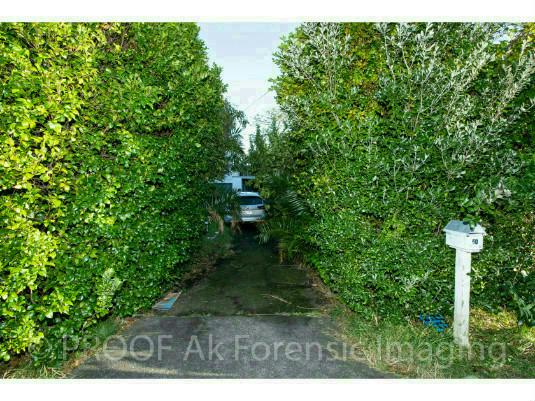
Fire Investigation Report
Page 6 of 44
Description and use of building
The dwelling involved in this fire was a residential two-level dwelling situated at 50 Rawhiti Road, Manly.
The dwelling consisted of five bedrooms with an open plan living, kitchen and dining area, with a total floor
area of approximately 210m2. It was constructed of a timber frame, clad in iron sheeting with aluminium
joinery and a corrugated iron roof.
Act
The interior of the property was timber framed and lined with plasterboard. The ceiling was metal framed,
lined with plasterboard.
The dwelling had been unoccupied since 2019, and power was not connected at the time of the fire.
Smoke detectors were not installed inside the dwelling.
The land around the dwelling was unmaintained and overgrown and the property was vandalised with
graffiti visible on the interior and exterior walls.
Information
Official
the
Under
Released
Photograph 1: Entry to the dwelling. (Courtesy of Police)

Fire Investigation Report
Page 7 of 44
Act
Information
Photograph 2: Manly village shops located directly adjacent to the address. Arrow indicating
location of CCTV camera. (Courtesy of Police)
Official
the
Under
Released

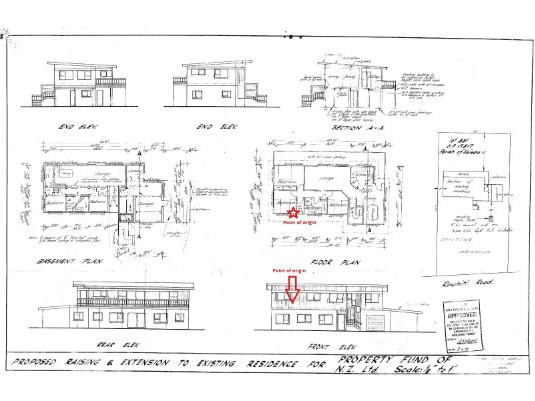
Fire Investigation Report
Page 8 of 44
Act
Information
Image 1: Location of the dwelling on the section.
Official
the
Under
Released
Image 2: Building Plans (Courtesy of Auckland Council)
Fire Investigation Report
Page 9 of 44
Act
Information
Official
the
Under
Released
Fire Investigation Report
Page 10 of 44
Pre-incident events
The weather on the day of the fire was overcast with passing showers, and the temperature was 15
degrees with strong winds 50-70kms blowing from the southwest.
The property in question had been unoccupied since 2019 and had gained a reputation among the local
police as a popular gathering spot for young individuals.
Act
According to the police, CCTV footage captured the presence of two
who entered the dwelling and
left approximately 5 minutes before the fire was reported to Fire and Emergency New Zealand.
Information
Official
the
Under
Released
Fire Investigation Report
Page 11 of 44
Discovery of fire
On June 6, 2023, at 2:38 a.m. the Fire and Emergency New Zealand Communication Centre received a
111-call reporting a house fire at 50 Rawhiti Road, Manly.
According to Witness 2, the first caller, they were driving through the area and noticed large amounts of
smoke coming from the property.
Act
Information
Official
the
Under
Released
Fire Investigation Report
Page 12 of 44
Fire and Emergency New Zealand response
Information sourced from Fire and Emergency Computer Aided Despatch Incident Report.
Incident Number
F3756563
Call Type
Method call received
111 Telephone
Incident date
6 Jun 2023 Act
Incident time
2:38:40 p.m.
1st Arrival
MANL911
2:51:46 p.m.
2nd Arrival
SILV907
2:53:27 p.m.
On June 6, 2023, at 2:38 a.m., the Fire and Emergency New Zealand Communication Centre received a
111-call reporting a house fire at 50 Rawhiti Road, Manly. Three fire appliances, two from Silverdale and
one from Manly, were dispatched. Upon arrival, the Manly 911 appliance transmitted a K99 (property fire
well involved) radio message, and firefighters quickly worked to extinguish the fire using one high-pressure
hose reel and one low pressure delivery hose. Police were also present at the scene.
Information
Manly
arrived at the scene approximately 4 minutes after the emergency call was received.
immediately contacted the fire communications centre to transmit a second alarm requesting additional
firefighting resources, recognizing the severity of the situation.
Official
According to observation, the fire had already gained significant intensity in a front bedroom upper level,
with flames visibly emanating from the front windows of the dwelling. The strong winds further accelerated
the spread of the fire throughout the upper levels, causing it to engulf the entire upper level.
the
By the time the Manly 911 fire appliance arrived at the scene, the fire had already taken hold and spread
through upper level of the building.
Under
Released

Fire Investigation Report
Page 13 of 44
Act
Information
Image 2: Photo at the time of arrival of Manly DCFO. Arrow indicating area of origin.
Official
the
Under
Released
Fire Investigation Report
Page 14 of 44
Process of investigation
Interviews
During the investigation, the Officer in Charge of the first arriving fire appliance and DCFO
was
interviewed to gather more information about the incident.
Witness 2 was also interviewed over the phone by me.
Act
Scene Examination
Upon arriving at the scene, I liaised with the Officer in Charge and police officers who were already on-site.
From the exterior of the building, I noted that the front bedroom had suffered the most fire damage.
In preparation for the investigation, a scene guard was arranged, and the investigation was scheduled to
begin at 8:00 a.m. on June 7, 2023, once a police photographer had arrived.
At 9:00 a.m., I returned to the incident and began the investigation. Prior to entering the house, I obtained
consent from the police to conduct a post-fire investigation and completed a risk assessment to identify any
Information
potential hazards.
The power authority had at ended the incident before my arrival and had confirmed that the power supply to
the dwelling was disconnected at the time of the fire
Official
Exterior Examination
West Profile
the
Lower level: No signs of fire damage were noted on the lower level of the dwelling. However, the presence
of mechanically1 broken windows suggests that these windows had been intentionally damaged, possibly
as acts of vandalism.
Under
Upper level: Fire damage was observed on all parts of the walls and windows of the upper level, indicating
that the fire spread throughout this area of the dwelling. The aluminium window frames had melted
approximately 3/4 of the way down suggesting that the fire reached high temperatures, estimated to be at
least 660 degrees Celsius. The extent of the fire damage on the upper level highlighted the intensity and
rapid spread of the fire.
Released
1
Analysis of Glass. Glass that has received an impact wil exhibit a characteristic cobweb pattern. The cracks wil be in straight lines and
numerous. The glass may have been broken before, during, or after the fire.
NFPA921 2021 edition 6.3.17.4.1

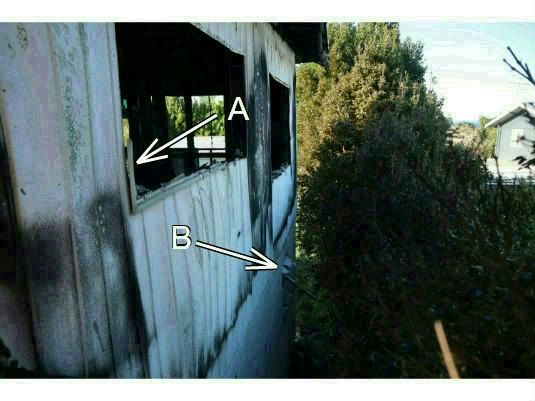
Fire Investigation Report
Page 15 of 44
Act
Information
Photograph 3: Mechanical window break on lower level.
Official
the
Under
Released
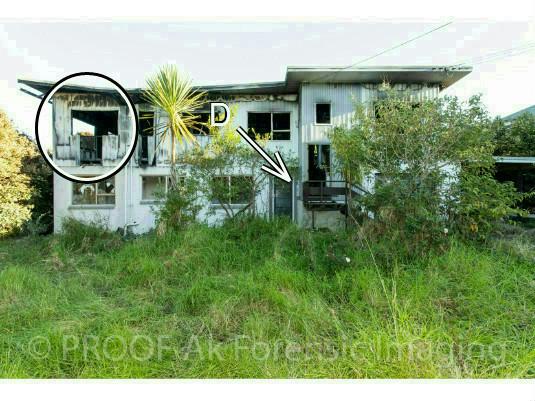
Fire Investigation Report
Page 16 of 44
Photograph 4: Arrow A indicating aluminium window frame melted Arrow B indicating lower broken window
from photograph 3.
South Profile
Lower Level: No signs of fire damage were noted on the lower level of the dwelling. The presence of
mechanically broken windows suggested possible acts of vandalism. The mains power board located on
Act
the wall near the front door was examined and did not show any signs of damage related to the fire
indicating that the fire did not originate or directly impact the power board.
Upper Level: Fire damage was observed on all parts of the walls and windows of the upper level,
indicating that the fire spread throughout this area of the dwelling. The greater extent of fire damage on the
west profile suggested that the fire was more intense in that area. Clean burning2 observed on metal wall
panels suggested higher temperatures in those areas. The roof supporting beams were burnt away and the
roof was slumping in the area of origin indicating significant fire involvement in this area. The melted PVC
storm water pipe attached to the front of the dwelling had slumped down to the lower level further indicating
Information
higher temperatures experienced on the upper level during the fire.
Official
the
Under
Released
2
Clean Burn. A distinct and visible fire effect generally apparent on non-combustible surfaces after combustible layer(s) (such as soot, paint,
and paper) have been burned away
NFPA921 2021 3.3.31
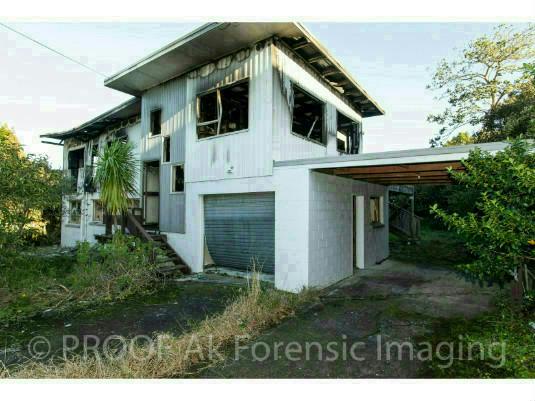
Fire Investigation Report
Page 17 of 44
Photograph 5: Circle indicating area of origin in upper-level bedroom 2. Arrow D indicating location of the
mains power meter. (Courtesy of Police)
Act
Information
Official
Photograph 6: View from the south-eastern profile. (Courtesy of Police)
the
Under
Released
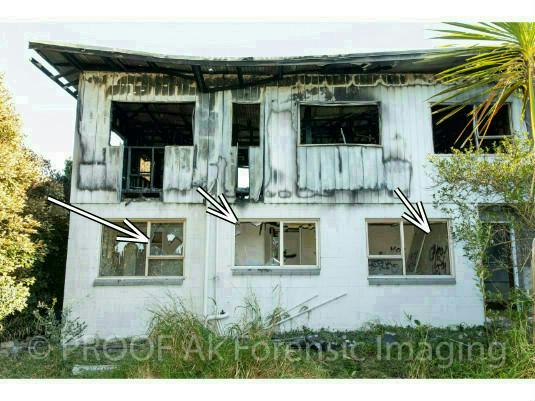
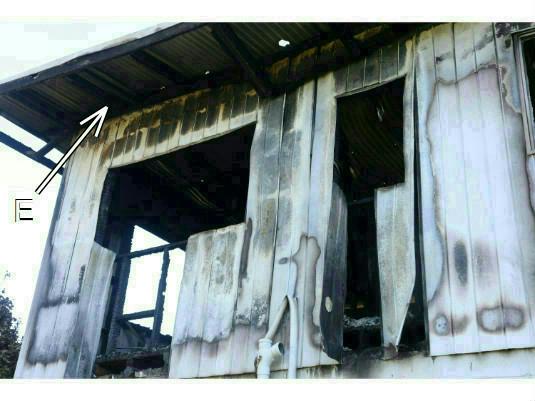
Fire Investigation Report
Page 18 of 44
Act
Information
Photograph 7: Arrows indicating mechanically windows broken on the lower levels. (Courtesy of Police)
Official
the
Under
Released
Photograph 7: Arrow E indicating soffit and timber support beams in the area of origin consumed by fire.

Fire Investigation Report
Page 19 of 44
Act
Information
Photograph 8: Mains power meter undamaged.
Official
East Profile:
the
Lower Level: No signs of fire damage were noted on the lower level of the dwelling. The presence of
mechanically broken windows in the garage area and graffiti suggested possible acts of vandalism.
The OIC stated that the doors on the east profile were all open at the time of arrival and fire crews did not
force entry.
Under
Upper Level: Fire damage was observed on all parts of the walls and windows on the upper level of the
dwelling, indicating that the fire had spread throughout this area. The strong gusting winds likely contributed
to the rapid spread of the fire.
On the east profile of the dwelling, the aluminium window frames remained intact at the top of the windows,
which indicated that the heat and fire intensity were greater on the west profile. Photograph 4 of the window
Released
on the west profile clearly shows the window frame melted approximately three-quarters of the way down,
indicating the intense heat experienced in that area
.
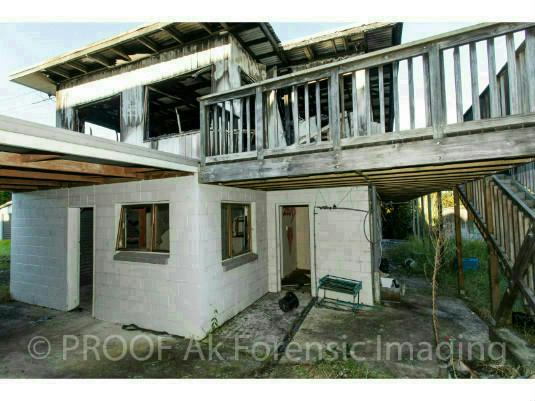
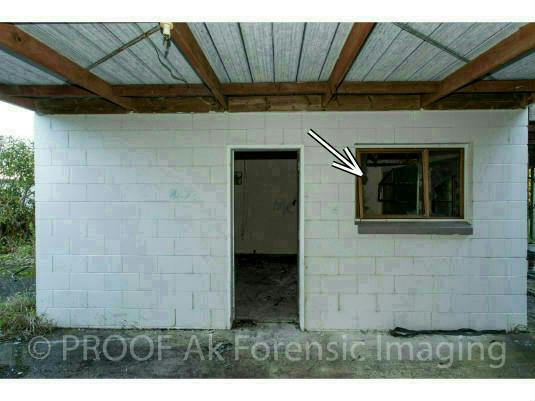
Fire Investigation Report
Page 20 of 44
Act
Information
Photograph 9: East profile of the dwelling. (Courtesy of Police)
Official
the
Under
Released
Photograph 9: Mechanically windows broken on the lower levels. (Courtesy of Police)

Fire Investigation Report
Page 21 of 44
Act
Information
Photograph 10: Arrows indicating aluminium window frames on east profile.
Official
the
North Profile: Lower Level: No signs of fire damage were noted on the lower level of the dwelling. The presence of
mechanically broken windows in the garage area and graffiti suggested possible acts of vandalism.
The OIC stated that the doors on the north profile were all open at the time of arrival and fire crews did not
Under
force entry.
Upper Level: Fire damage was observed on all walls and windows on the upper level of the dwelling,
indicating the widespread fire in this area. The presence of two large aluminium ranch sliding windows,
once broken, would have provided a ventilation pathway for the fire, which would have contributed to the
fire intensity.
Released
Additionally, a large wooden deck covering the entire length of the dwelling was located on the upper level
of the north profile. This deck exhibited greater amounts of charring towards the west profile of the dwelling,
indicating the path of the fire. Other than the charring the deck was still mostly intact.

Fire Investigation Report
Page 22 of 44
The fire intensity on the north profile of the dwelling was particularly severe due to the strong gusting winds
at the time of the fire. These winds had forced the fire to spread from the south to the north, causing
increased heat and flames on the north-facing side of the dwelling in turn creating the visible fire damage
.
Act
Information
Official
Photograph 11: North profile of the dwelling.
the
Under
Released

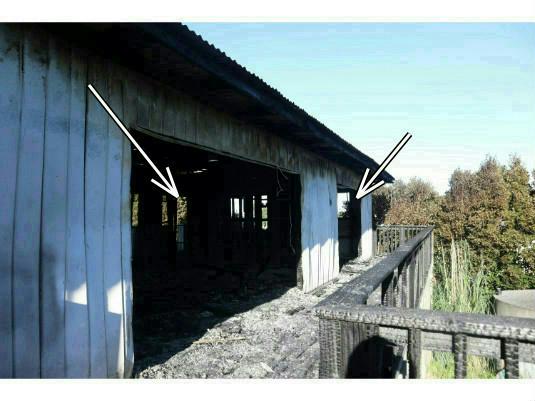
Fire Investigation Report
Page 23 of 44
Act
Information
Photograph 12: Arrow F indicating mechanically windows broken on the lower levels. Arrow G open sliding
door. (Courtesy of Police)
Official
the
Under
Released
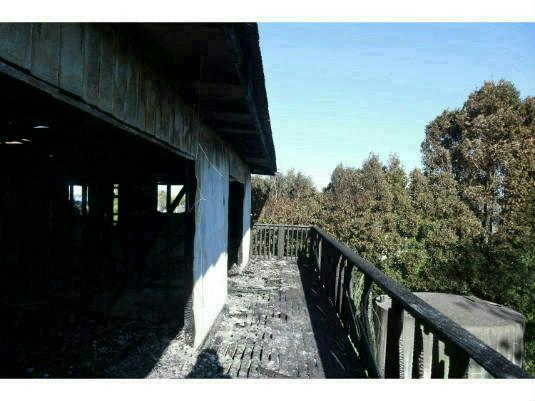
Fire Investigation Report
Page 24 of 44
Photograph 13: Location on the two large sliding windows.
Act
Information
Official
Photograph 14: Deck located on the upper-level north profile.
the
Under
Released

Fire Investigation Report
Page 25 of 44
Act
Information
Photograph 15: Stairs leading to upper-level deck. (Courtesy of Police)
Official
Interior examination:
the
An examination of the interior of the house was undertaken in order of least to most fire damaged areas.
Lower ground level:
Under
Garage: The garage area of the dwelling, located on the east profile, did not show any signs of fire
damage. It appeared that the garage door had been damaged prior to the fire incident.
There was some fire debris observed in the garage, which likely fell from the upper level of the dwelling.
This was due to the flooring of the upper level collapsing in several spots. The fallen debris indicated the
extent of the fire's impact on the upper level and its subsequent effects on the lower areas, including the
garage.
Released

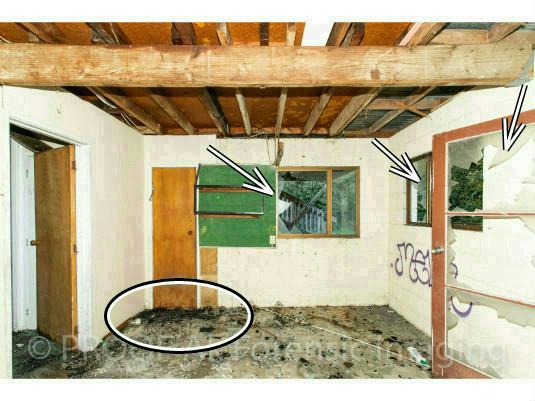
Fire Investigation Report
Page 26 of 44
Act
Information
Photograph 16: Garage area of the dwelling. (Courtesy of Police)
Official
the
Under
Released

Fire Investigation Report
Page 27 of 44
Photograph 17: Garage area of the dwelling. Circle indicating fire debris. Arrows indicating broken glass on
doors. (Courtesy of Police)
Front door and entrance way lower ground: No signs of a smoke or fire damage were observed in this
area.
Act
Information
Official
the
Photograph 18: Front door and entry way into the dwelling. (Courtesy of Police)
Under
Lower ground living area: No signs of a smoke or fire damage were observed in this area.
The main fuse board for the dwelling, located on the wall in the lower ground living area, was examined and
showed no signs of fire damage.
Released

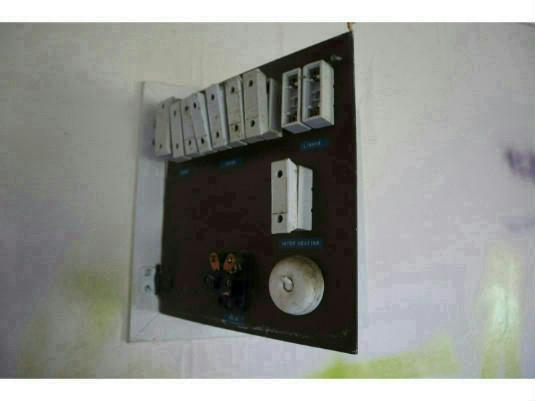
Fire Investigation Report
Page 28 of 44
Act
Information
Photograph 19: Living area on the lower ground floor. Arrow indicating located of the fuse board. (Courtesy
of Police)
Official
the
Under
Released

Fire Investigation Report
Page 29 of 44
Photograph 20: Fuse board
Act
Information
Official
Photograph 21: Cables at the rear of the fuse board.
the
Bedroom 1 lower ground: A small table was located in the room and the bedroom windows appeared to
have been mechanically broken.
There was some fire debris observed on the floor, which likely fell from the upper level of the dwelling. This
was due to the flooring of the upper-level collapsing in several spots.
Under
Located directly above bedroom 1 was the upper-level bathroom. Witness 2 stated that the flooring around
the bath area was rotting away. Upon inspection, it was evident that the flooring in this area had failed and
given way, creating a hole in the floor. The exposed timber joists were significantly charred indicating a fire
burning above them in this area.
Released


Fire Investigation Report
Page 30 of 44
Act
Information
Photograph 22: Bedroom 1 lower ground floor. (Courtesy of Police)
Official
the
Under
Released
Photograph 23: Celling in bedroom 1 (Courtesy of Police)
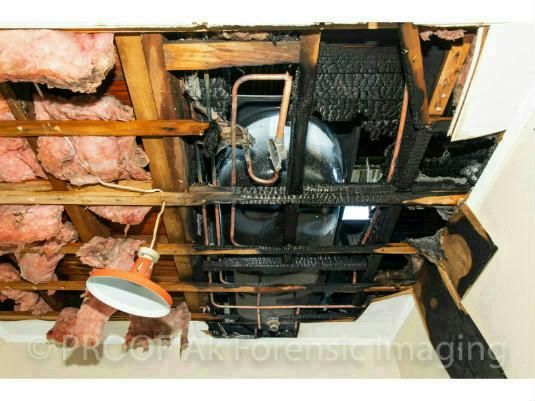
Fire Investigation Report
Page 31 of 44
Act
Information
Photograph 24: Bathtub from above room. (Courtesy of Police)
Official
Bedroom 2 lower ground: The ceiling in bedroom 2 on the lower ground had been completely burnt away
the
and burnt debris had collected on the floor below, but the rest of the room was undamaged by fire. During
examination of the fire debris, the delayering process revealed the significant consumption of a large
section of flooring from the above room.
A ppb RAE 3000 photoionisation detector (PID) was used to test for the presence of volatile organic
Under
compounds (VOCs). The presence of VOCs may suggest a flammable liquid has been present at the time
of a fire. The PID indicated elevated levels of VOCs around the corner of the bedroom in contrast to the
surrounding areas, I recommended to the police that they remove samples in this area for forensic testing
There was an irregular burn pattern3 on the upper section of the wall corresponding with the corner of the
above room below the eternal window. The surround burning on the timber joists was also more significant
Released
3
Irregular Burn Patterns. Irregular patterns are common in situations of post flashover conditions, long extinguishing times, or building
collapse. These patterns may result from the effects of hots gases, flaming and smoldering debris, melted plastics, or ignitable liquids.
NFPA921 2021 edition 6.3.20.7 Where overall fire damage is limited and small or isolated irregular patterns are found, further examination
should be conducted for supporting evidence of ignitable liquids.
6.3.20.7.3
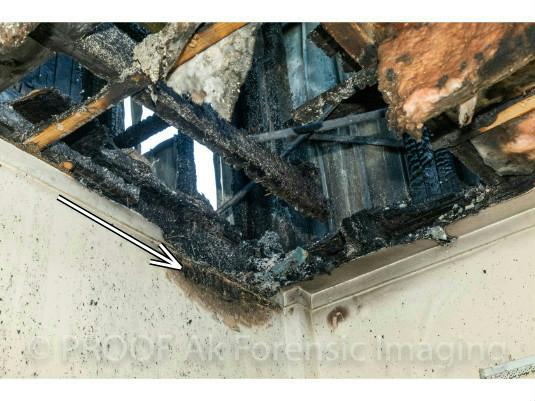
Fire Investigation Report
Page 32 of 44
in his area. This pattern was consistent with a possible flammable liquid seeping into this area and being
ignited causing localised burning.
Act
Information
Official
Photograph 25: Arrow indicating irregular burn patterns in bedroom 2. (Courtesy of Police)
the
Under
Released

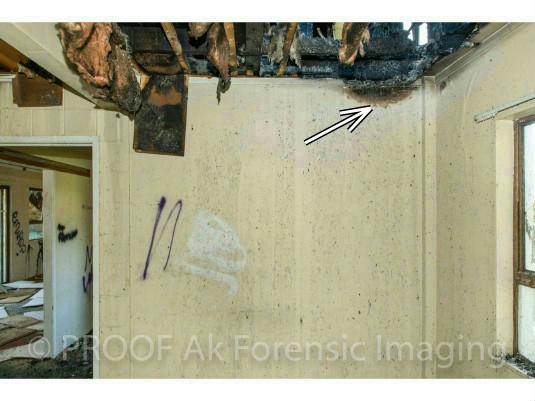
Fire Investigation Report
Page 33 of 44
Act
Information
Photograph 26: Arrow indicating irregular burn patterns. (Courtesy of Police)
Official
the
Under
Released
Photograph 27: Arrow indicating irregular burn patterns. (Courtesy of Police)
Fire Investigation Report
Page 34 of 44
Upper Level of the dwelling: The upper level of the dwelling consisted of three bedrooms, one bathroom, and one kitchen area. Due to
the severe compromise of the flooring, a full examination of the upper level was unable to be completed.
In comparison to the bedrooms and hallway, the kitchen area located on the east profile of the dwelling Act
exhibited the least amount of fire damage. The fire intensity in this area was likely mitigated by factors such
as the layout and materials present.
In the kitchen area of the upper level, some sections of gypsum plasterboard remain intact, indicating a
partial preservation of the wall surfaces. In contrast, in the bedroom and hallway areas, the gypsum
plasterboard had been completely consumed by the fire, leaving only charred remnants. This difference
suggested that the fire intensity and duration were higher in the bedroom and hallway areas.
The electrical wiring in the kitchen area still retained its insulation, indicating that the fire did not reach
Information
temperatures high enough to cause significant damage to the wiring. However, in the bedroom area, the
insulation has been burned away, leaving only the bare copper wire. This suggested that the fire in the
bedroom area reached higher temperatures, leading to the destruction of the insulation on the electrical
wiring.
The lounge room area, on the other hand, showed significant fire damage. This can be attributed to the
Official
high winds and the ventilation pathway created by the two large ranch sliding windows. The fire dynamics
in this area were influenced by the open windows, which allowed for increased air flow and the rapid spread
of the fire.
the
The area encompassing bedroom 1 and bedroom 2 experienced the most intense burning where the roof
support joists were burnt away by the fire and the tin roof started to bow. A large hole had formed in the
floor in this area as well, indicating the extensive damage caused by the fire. This damage corresponded
to the photo taken upon the arrival of the Manly DCFO.
Under
Released
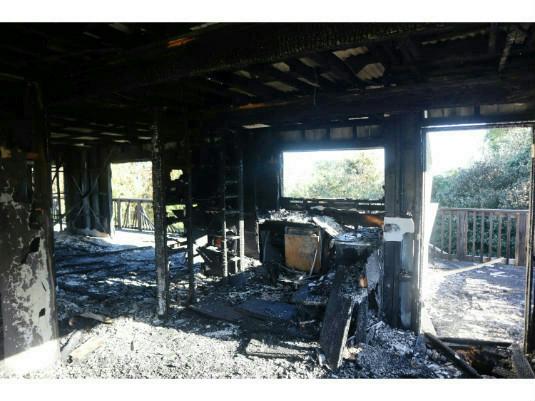

Fire Investigation Report
Page 35 of 44
Act
Information
Photograph 28: Kitchen/Living area on upper level. Area of least damage.
Official
the
Under
Released
Photograph 29: Kitchen appliances unused for some time.
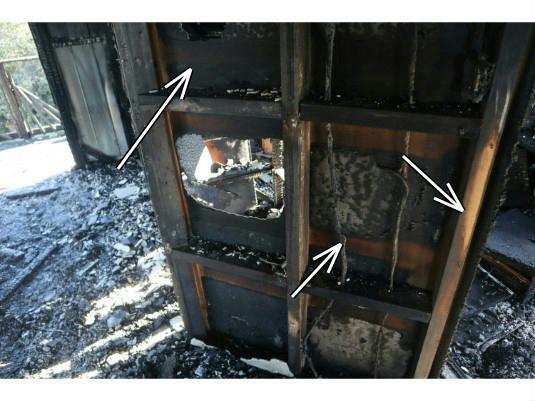
Fire Investigation Report
Page 36 of 44
Act
Information
Photograph 30: Unburnt timber wall framing in the kitchen and electrical cables that still have insulation
Official
present.
the
Under
Released


Fire Investigation Report
Page 37 of 44
Act
Information
Photograph 31: Bedroom light switch in area of origin. Examined no signs of failure.
Official
the
Under
Released
Photograph 32: Lounge room area looking towards front of the dwelling. (Courtesy of Police)

Fire Investigation Report
Page 38 of 44
Act
Information
Photograph 33: Hallway area leading to bedrooms and area of origin. (Courtesy of Police)
Official
the
Under
Released
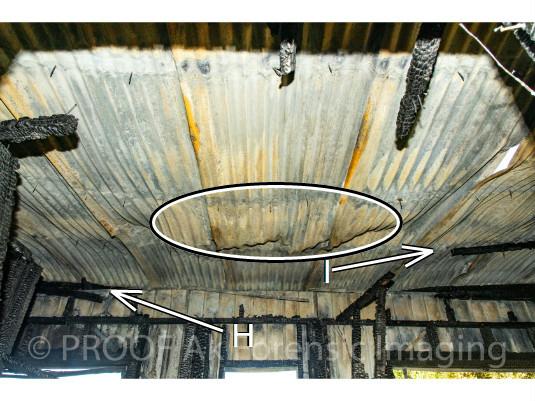
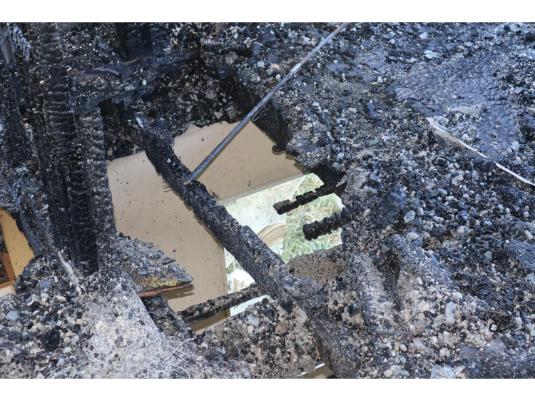
Fire Investigation Report
Page 39 of 44
Act
Information
Photograph 34: Roof in the area of origin (Bedroom 2). Arrow I timber roof purlins consumed by fire. Circle
indicating Roofing iron starting to bow. Arrow H Wall plates consumed by fire. (Courtesy of Police)
Official
the
Under
Released
Fire Investigation Report
Page 40 of 44
Photograph 35: Consumption of a large section of flooring in the corner of the bedroom at the point origin.
Act
Information
Official
the
Under
Released
Fire Investigation Report
Page 41 of 44
Area and point of origin
Area of Origin
The area of origin of the fire was determined to be in bedroom 2 of the upper level of the dwelling. Upon
investigation, it was found that the fire originated within this specific area and then spread to other parts of
the room and beyond.
Point of Origin
Act
The point of origin of the fire was determined to be the corner of the wall beneath the window located in
bedroom 2 in the area of the irregular burn pattern was exhibited. Upon investigation, it was found that the
fire originated from this area and then spread to other parts of the room.
Information
Official
the
Under
Released
Fire Investigation Report
Page 42 of 44
Conclusions
Supposed Cause
Based on the evidence available at the time of this investigation, the classification of this incident has been
recorded as Incendiary
During the investigation, several indicators of forced entry were discovered around the bedroom windows
and doors, however, it is unknown when this damage had occurred. Traces of a volatile organic compound
Act
found at the scene may support the conclusion that this fire was intentionally set.
Based on the gathered evidence, it is believed that the cause of the fire was the deliberate ignition of an
ignitable liquid. The liquid had been poured around the corner end of the bedroom and the surrounding
floor area, leading to the rapid spread of the flames.
Elimination of Other Possible Causes
Upon further examination, it was determined that there was no damage to the wiring in the area of origin.
Information
As a result, an electrical cause was ruled out as the source of the fire. The fuse box and mains power
meter were found to be undamaged, and Vector, the electricity provider, confirmed that the power had been
disconnected for four years.
Weather events were also ruled out as a potential cause, as there were no recorded weather disturbances
at the time of the incident.
Official
Furthermore, upon thorough investigation, no other competent ignition sources were found in the point of
origin area. This further supports the conclusion that the fire was deliberately set using an ignitable liquid.
the
Under
Released
Fire Investigation Report
Page 43 of 44
Report approvals
Investigation and report completed by:
Investigator
Name: Michael Hoyne
Job Title: Specialist Fire Investigator
Act
Date: 20 July 2023 02:01p.m.
I confirm the truth and accuracy of this statement. I make the statement with the knowledge that it is to be
used in court proceedings. I am aware that it is an offence to make a statement that is known by me to be
false or intended by me to mislead.
Information
A technical review of this report has been completed by:
Name:
Job Title:
Date:
Official
This report has been approved by:
the
Name:
Job Title:
Date:
Under
Released
Fire Investigation Report
Page 44 of 44
Appendix 1: Witness Details
Removed in compliance with the Privacy Act 2020 and the Official Information Act 1982
Act
Information
Official
the
Under
Released











































